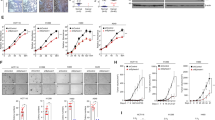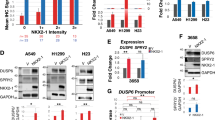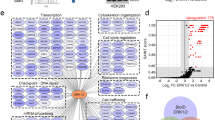Abstract
The ability of cells to invade into the dermis is a critical event in the development of cutaneous melanoma and ultimately an indicator of poor prognosis. However, the molecular events surrounding the acquisition of this invasive phenotype remain incompletely understood. Mutations in B-RAF are frequent in melanoma and are known to regulate the invasive phenotype. In this study, we sought to determine the molecular mechanisms controlling melanoma invasion. We found that mutant B-RAF signaling regulates a cadherin switch. In melanoma cells expressing mutant B-RAF we observed high levels of N-cadherin and low levels of E-cadherin. Depletion of mutant B-RAF, by small interfering RNA, caused a decrease in the levels of N-cadherin and an increase in the levels of E-cadherin. Mechanistically, we found that this cadherin switch required the activity of Rac1 and its GEF, Tiam1, both of which show suppressed activity in the presence of mutant B-RAF. Consistent with the work of others, we found that depletion of mutant B-RAF decreased the invasive capacity of the melanoma cells. However, simultaneous depletion of B-RAF and Rac or Tiam1 resulted in invasive capacity similar to that of control cells. Taken together, our results suggest that mutant B-RAF signaling downregulates Tiam1/Rac activity resulting in an increase in N-cadherin levels and a decrease in E-cadherin levels and ultimately enhanced invasion.
This is a preview of subscription content, access via your institution
Access options
Subscribe to this journal
Receive 50 print issues and online access
$259.00 per year
only $5.18 per issue
Buy this article
- Purchase on Springer Link
- Instant access to full article PDF
Prices may be subject to local taxes which are calculated during checkout











Similar content being viewed by others
References
Sauter ER, Herlyn M . Molecular biology of human melanoma development and progression. Mol Carcinog 1998; 23: 132–143.
Chin L . The genetics of malignant melanoma: lessons from mouse and man. Nat Rev Cancer 2003; 3: 559–570.
Davies H, Bignell GR, Cox C, Stephens P, Edkins S, Clegg S et al. Mutations of the BRAF gene in human cancer. Nature 2002; 417: 949–954.
Pollock PM, Cohen-Solal K, Sood R, Namkoong J, Martino JJ, Koganti A et al. Melanoma mouse model implicates metabotropic glutamate signaling in melanocytic neoplasia. Nat Genet 2003; 34: 108–112.
Dong J, Phelps RG, Qiao R, Yao S, Benard O, Ronai Z et al. BRAF oncogenic mutations correlate with progression rather than initiation of human melanoma. Cancer Res 2003; 63: 3883–3885.
Sumimoto H, Miyagishi M, Miyoshi H, Yamagata S, Shimizu A, Taira K et al. Inhibition of growth and invasive ability of melanoma by inactivation of mutated BRAF with lentivirus-mediated RNA interference. Oncogene 2004; 23: 6031–6039.
Tsai J, Lee JT, Wang W, Zhang J, Cho H, Mamo S et al. Discovery of a selective inhibitor of oncogenic B-Raf kinase with potent antimelanoma activity. Proc Natl Acad Sci USA 2008; 105: 3041–3046.
Vleminckx K, Kemler R . Cadherins and tissue formation: integrating adhesion and signaling. Bioessays 1999; 21: 211–220.
Hsu MY, Wheelock MJ, Johnson KR, Herlyn M . Shifts in cadherin profiles between human normal melanocytes and melanomas. J Investig Dermatol Symp Proc 1996; 1: 188–194.
Silye R, Karayiannakis AJ, Syrigos KN, Poole S, van NS, Batchelor W et al. E-cadherin/catenin complex in benign and malignant melanocytic lesions. J Pathol 1998; 186: 350–355.
Tang A, Eller MS, Hara M, Yaar M, Hirohashi S, Gilchrest BA . E-cadherin is the major mediator of human melanocyte adhesion to keratinocytes in vitro. J Cell Sci 1994; 107 (Pt 4): 983–992.
Hsu M, Andl T, Li G, Meinkoth JL, Herlyn M . Cadherin repertoire determines partner-specific gap junctional communication during melanoma progression. J Cell Sci 2000; 113 (Pt 9): 1535–1542.
Sandig M, Voura EB, Kalnins VI, Siu CH . Role of cadherins in the transendothelial migration of melanoma cells in culture. Cell Motil Cytoskeleton 1997; 38: 351–364.
Li G, Satyamoorthy K, Herlyn M . N-cadherin-mediated intercellular interactions promote survival and migration of melanoma cells. Cancer Res 2001; 61: 3819–3825.
Braga VM, Machesky LM, Hall A, Hotchin NA . The small GTPases Rho and Rac are required for the establishment of cadherin-dependent cell-cell contacts. J Cell Biol 1997; 137: 1421–1431.
Takaishi K, Sasaki T, Kotani H, Nishioka H, Takai Y . Regulation of cell-cell adhesion by rac and rho small G proteins in MDCK cells. J Cell Biol 1997; 139: 1047–1059.
Hordijk PL, ten Klooster JP, van der Kammen RA, Michiels F, Oomen LC . Collard JG. Inhibition of invasion of epithelial cells by Tiam1-Rac signaling. Science 1997; 278: 1464–1466.
Habets GG, Scholtes EH, Zuydgeest D, van der Kammen RA, Stam JC, Berns A et al. Identification of an invasion-inducing gene, Tiam-1, that encodes a protein with homology to GDP-GTP exchangers for Rho-like proteins. Cell 1994; 77: 537–549.
Michiels F, Collard JG . Rho-like GTPases: their role in cell adhesion and invasion. Biochem Soc Symp 1999; 65: 125–146.
Engers R, Springer E, Michiels F, Collard JG, Gabbert HE . Rac affects invasion of human renal cell carcinomas by up-regulating tissue inhibitor of metalloproteinases (TIMP)-1 and TIMP-2 expression. J Biol Chem 2001; 276: 41889–41897.
Calipel A, Lefevre G, Pouponnot C, Mouriaux F, Eychene A, Mascarelli F . Mutation of B-Raf in human choroidal melanoma cells mediates cell proliferation and transformation through the MEK/ERK pathway. J Biol Chem 2003; 278: 42409–42418.
Bollag G, Hirth P, Tsai J, Zhang J, Ibrahim PN, Cho H et al. Clinical efficacy of a RAF inhibitor needs broad target blockade in BRAF-mutant melanoma. Nature 2010; 467: 596–599.
Gao Y, Dickerson JB, Guo F, Zheng J, Zheng Y . Rational design and characterization of a Rac GTPase-specific small molecule inhibitor. Proc Natl Acad Sci USA 2004; 101: 7618–7623.
Akbar H, Cancelas J, Williams DA, Zheng J, Zheng Y . Rational design and applications of a Rac GTPase-specific small molecule inhibitor. Methods Enzymol 2006; 406: 554–565.
Albino AP, Nanus DM, Mentle IR, Cordon-Cardo C, McNutt NS, Bressler J et al. Analysis of ras oncogenes in malignant melanoma and precursor lesions: correlation of point mutations with differentiation phenotype. Oncogene 1989; 4: 1363–1374.
Garcia-Mata R, Wennerberg K, Arthur WT, Noren NK, Ellerbroek SM, Burridge K . Analysis of activated GAPs and GEFs in cell lysates. Methods Enzymol 2006; 406: 425–437.
Stam JC, Sander EE, Michiels F, van Leeuwen FN, Kain HE, van der Kammen RA et al. Targeting of Tiam1 to the plasma membrane requires the cooperative function of the N-terminal pleckstrin homology domain and an adjacent protein interaction domain. J Biol Chem 1997; 272: 28447–28454.
Zhang JD, Koerner C, Bechtel S, Bender C, Keklikoglou I, Schmidt C et al. Time-resolved human kinome RNAi screen identifies a network regulating mitotic-events as early regulators of cell proliferation. PLoS One 2011; 6: e22176.
Li G, Satyamoorthy K, Herlyn M . Dynamics of cell interactions and communications during melanoma development. Crit Rev Oral Biol Med 2002; 13: 62–70.
Hirohashi S . Inactivation of the E-cadherin-mediated cell adhesion system in human cancers. Am J Pathol 1998; 153: 333–339.
Poser I, Dominguez D, de Herreros AG, Varnai A, Buettner R, Bosserhoff AK . Loss of E-cadherin expression in melanoma cells involves up-regulation of the transcriptional repressor Snail. J Biol Chem 2001; 276: 24661–24666.
Massoumi R, Kuphal S, Hellerbrand C, Haas B, Wild P, Spruss T et al. Down-regulation of CYLD expression by Snail promotes tumor progression in malignant melanoma. J Exp Med 2009; 206: 221–232.
Arozarena I, Sanchez-Laorden B, Packer L, Hidalgo-Carcedo C, Hayward R, Viros A et al. Oncogenic BRAF induces melanoma cell invasion by downregulating the cGMP-specific phosphodiesterase PDE5A. Cancer Cell 2011; 19: 45–57.
Goodall J, Carreira S, Denat L, Kobi D, Davidson I, Nuciforo P et al. Brn-2 represses microphthalmia-associated transcription factor expression and marks a distinct subpopulation of microphthalmia-associated transcription factor-negative melanoma cells. Cancer Res 2008; 68: 7788–7794.
Kuroda S, Fukata M, Fujii K, Nakamura T, Izawa I, Kaibuchi K . Regulation of cell-cell adhesion of MDCK cells by Cdc42 and Rac1 small GTPases. Biochem Biophys Res Commun 1997; 240: 430–435.
Zhong C, Kinch MS, Burridge K . Rho-stimulated contractility contributes to the fibroblastic phenotype of Ras-transformed epithelial cells. Mol Biol Cell 1997; 8: 2329–2344.
Jou TS, Schneeberger EE, Nelson WJ . Structural and functional regulation of tight junctions by RhoA and Rac1 small GTPases. J Cell Biol 1998; 142: 101–115.
Stam JC, Michiels F, van der Kammen RA, Moolenaar WH, Collard JG . Invasion of T-lymphoma cells: cooperation between Rho family GTPases and lysophospholipid receptor signaling. EMBO J 1998; 17: 4066–4074.
Smalley KS . A pivotal role for ERK in the oncogenic behaviour of malignant melanoma? Int J Cancer 2003; 104: 527–532.
Alsina J, Gorsk DH, Germino FJ, Shih W, Lu SE, Zhang ZG et al. Detection of mutations in the mitogen-activated protein kinase pathway in human melanoma. Clin Cancer Res 2003; 9: 6419–6425.
Dumaz N, Hayward R, Martin J, Ogilvie L, Hedley D, Curtin JA et al. In melanoma, RAS mutations are accompanied by switching signaling from BRAF to CRAF and disrupted cyclic AMP signaling. Cancer Res 2006; 66: 9483–9491.
Ray RM, Vaidya RJ, Johnson LR . MEK/ERK regulates adherens junctions and migration through Rac1. Cell Motil Cytoskeleton 2007; 64: 143–156.
Zondag GC, Evers EE, ten Klooster JP, Janssen L, van der Kammen RA, Collard JG . Oncogenic Ras downregulates Rac activity, which leads to increased Rho activity and epithelial-mesenchymal transition. J Cell Biol 2000; 149: 775–782.
Sander EE, van DS, ten Klooster JP, Reid T, van der Kammen RA, Michiels F et al. Matrix-dependent Tiam1/Rac signaling in epithelial cells promotes either cell-cell adhesion or cell migration and is regulated by phosphatidylinositol 3-kinase. J Cell Biol 1998; 143: 1385–1398.
Uhlenbrock K, Eberth A, Herbrand U, Daryab N, Stege P, Meier F et al. The RacGEF Tiam1 inhibits migration and invasion of metastatic melanoma via a novel adhesive mechanism. J Cell Sci 2004; 117 (Pt 20): 4863–4871.
Klein RM, Spofford LS, Abel EV, Ortiz A, Aplin AE . B-RAF regulation of Rnd3 participates in actin cytoskeletal and focal adhesion organization. Mol Biol Cell 2008; 19: 498–508.
Klein RM, Aplin AE . Rnd3 regulation of the actin cytoskeleton promotes melanoma migration and invasive outgrowth in three dimensions. Cancer Res 2009; 69: 2224–2233.
Acknowledgements
This work was supported by NIH grants GM029860 and HL080166 to KB. E M-B is supported by American Cancer Society PF-09_119-01-CSM.
Author information
Authors and Affiliations
Corresponding author
Ethics declarations
Competing interests
The authors declare no conflict of interest.
Rights and permissions
About this article
Cite this article
Monaghan-Benson, E., Burridge, K. Mutant B-RAF regulates a Rac-dependent cadherin switch in melanoma. Oncogene 32, 4836–4844 (2013). https://doi.org/10.1038/onc.2012.492
Received:
Revised:
Accepted:
Published:
Issue Date:
DOI: https://doi.org/10.1038/onc.2012.492
Keywords
This article is cited by
-
IRGM1 enhances B16 melanoma cell metastasis through PI3K-Rac1 mediated epithelial mesenchymal transition
Scientific Reports (2015)



